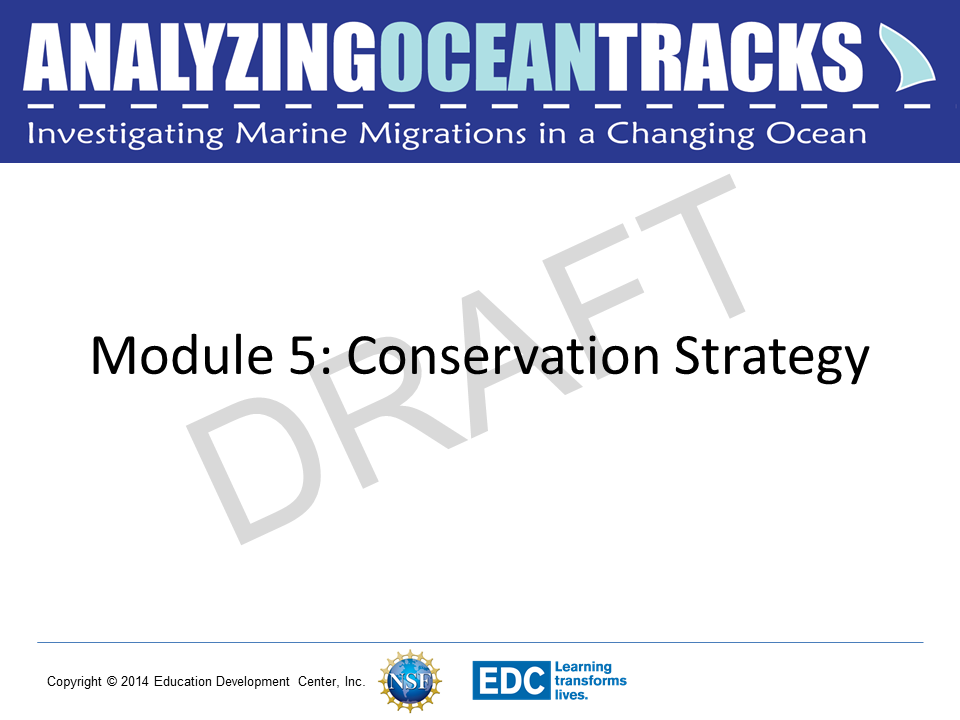Curriculum
This curriculum guides students (high school and undergraduate levels) through an exploration of data using the Ocean Tracks interface. Students acquire critical scientific inquiry and data-analysis skills as they investigate the same questions as scientists looking at the movements of marine animals in the Pacific Ocean and their relationship to the ocean environment and human activities.
Please email contact@edc.org for access to teacher guide materials.
Fact of Artifact?: Interpreting Patterns in Ocean Tracks Data
The tracking data in Ocean Tracks have been a powerful tool for scientists, revealing animal behaviors never before understood. You’ll use these data to develop your own new insights about these animals, but beware—to extract meaningful patterns and separate facts from artifacts, you need to take a critical look at the data. You should assess the quality and accuracy of measurements, understand how the data are collected and represented in the Ocean Tracks interface, and apply background information about tagging technologies and animal behaviors.
PDF | PPT
 What's Up in the Pacific Ocean?: Connecting Productivity and Tuna Migration
What's Up in the Pacific Ocean?: Connecting Productivity and Tuna Migration
In this module, you will follow a bluefin tuna on a spectacular migratory journey up and down the West Coast of North America and back and forth across the Pacific Ocean to investigate the hypothesis that Bluefin Tuna #201000 migrates to areas of the Pacific Ocean with high productivity.
PDF | PPT
 Faster, Farther, Deeper: Exploring the Physiology of Highly Migratory Ocean Predators
Faster, Farther, Deeper: Exploring the Physiology of Highly Migratory Ocean Predators
In this module, you will explore marine habitat usage in three dimensions and design an experiment to explore in greater depth how physiology influences the ways in which different species use the ocean environment.
PDF | PPT
 Do You Come Here Often?: The Making of Biological Hotspots
Do You Come Here Often?: The Making of Biological Hotspots
In this module, you will discover where and why top predators congregate in the North Pacific Ocean.
PDF | PPT
 He Fed, She Fed
He Fed, She Fed
In this module, you will learn how migration patterns can provide key insights into the biology and ecology of ocean-going species by investigating the following question: Is Elephant Seal #302 male or female?
PDF | PPT
 Saving Sharks: Proposing a New Marine Protected Area
Saving Sharks: Proposing a New Marine Protected Area
What would be the ideal characteristics of a marine protected area designed to conserve white sharks in the Pacific Ocean?
PDF | PPT
Original High School Modules
For teachers using our original high school modules, they can be found below. Please click on the image to the left to download the module as a PowerPoint file on to your computer. (Note: The revised modules (above) were based on these original high school modules, but were further refined based on feedback from teachers and students. We encourage you to check out the “new improved” versions of the modules and see how they work for you!)
 Module 1: Introduction to Ocean Tracks
Module 1: Introduction to Ocean Tracks
In this introductory module, students become familiar with the Ocean Tracks interface and species, using the measurement tools to find the individuals that have traveled the furthest and the fastest.
 Module 2: Prey Maps
Module 2: Prey Maps
Students take measurements of animal tracks to identify feeding behavior, and then inspect sea surface chlorophyll concentration maps to develop claims about where the prey of the elephant seal are likely located.
 Module 3: Biological Hotspots
Module 3: Biological Hotspots
Students use the animal tracking data and the hotspot tool to find areas of high biological activity in the Pacific Ocean, and then inspect sea surface temperature and chlorophyll data to identify the underlying oceanography processes that create these hotspots.
 Module 4: Human Impacts
Module 4: Human Impacts
Students inspect a map overlay showing the intensity of human impacts in the Pacific Ocean to look for potential interactions between human activities and marine animals in their hotspots.
 Module 5: Conservation Strategy
Module 5: Conservation Strategy
Students synthesize the data and information they’ve collected while using Ocean Tracks to design a mobile sanctuary to protect marine species.
Teacher Guide
This document was used with the Learning Modules in classroom tests during fall 2013. Click to download the .pdf file.


